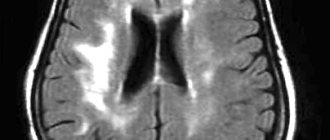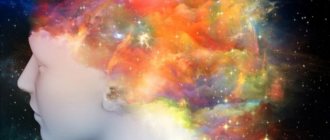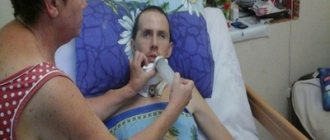Classification and characteristic signs of the disease
Lennox-Gastaut syndrome can have a different clinical picture. It depends on the type of lesions of the central nervous system and the reasons that caused their formation. It is customary to distinguish several types of symptoms:
- Atonic seizures are accompanied by loss or severe decrease in muscle tone. The patient is unable to control his own movements. If the attack lasts several seconds, it may remain invisible to others, which is especially dangerous in young children who are not able to talk about what happened. Loss of consciousness and falls are common during atony.
- Myoclonic paroxysms are characterized by specific muscle contractions that look like twitching of the limbs and torso. They are characterized by symmetry, that is, both halves of the body are affected at once. A distinctive feature is the stereotypic nature of the patient’s movements. When the legs are involved in the pathological process, children and adults fall, which provokes injuries.
- Tonic attacks do not last long and are often recorded at night. This makes it difficult to differentiate them from another form of epilepsy - pseudo-Lennox syndrome, which is accompanied by pathological electrical activity of the brain during slow sleep (ESES - “electrical status epilepticus during slow sleep”). Unlike the latter, no specific paroxysm is detected in the process of taking an electroencephalogram. Tonic seizures are short-lived. They are dangerous due to loss of consciousness, autonomic disorders and respiratory arrest.
- Atypical absence seizures are one of the main signs of Lennox-Gastaut syndrome. There is a partial disturbance of perception. Patients become immobile for a short period of time. Motor manifestations are different: from atony to hypertonicity of individual muscle groups. When similar signs of Lennox-Gastaut syndrome occur in children, they often go unnoticed because they last only a few seconds.
- Delayed psychomotor development accompanies many mental disorders. It represents the patient's inability to remember new information and learn skills. Children have difficulty mastering spoken language and school discipline. Adults with Lennox-Gastaut syndrome also show signs of developmental delays, which also affect socialization. Such a person is incapable of self-care and needs outside help. Although adaptation is possible, it can only be achieved in 15% of cases.
Signs and symptoms
Symptoms of Lennox-Gastaut syndrome usually begin in infancy or childhood, most often between 3 and 5 years of age. Children with LGS are affected by several types of seizures, which are basically electrical disturbances in the brain. Most patients experience several types of seizures, several times during the day. As patients get older, the types and frequency of attacks may change.
The most common types of seizures associated with Lennox-Gastaut syndrome are tonic and atonic seizures. Tonic seizures cause increased muscle tone and muscle stiffness. They are characterized by sustained muscle contractions that can cause mild disturbances, such as slight bending of the body and momentary interruptions in breathing, or more serious problems, such as muscle spasms of the face and flexion or extension of the arms and legs. Affected children may extend their arms above their heads like a ballerina. Tonic seizures are usually short-lived (lasting a few seconds to a minute) and are especially common at night during sleep, but can also occur during the day. During a tonic seizure, a brief loss of consciousness usually occurs. Tonic seizures that occur upon awakening can cause patients to fall out of bed.
Atonic seizures cause a sudden loss of muscle tone and lethargy. They can lead to head nodding, posture problems, or sudden falls. Atonic seizures are also known as falling seizures. Atonic seizures can lead to head and facial injuries due to sudden, unexpected falls. While sitting, affected people may fall forward or backward at the waist. Atonic seizures may only partially affect consciousness and usually last only a few seconds
The third type of seizure commonly associated with Lennox-Gastaut syndrome is atypical absence seizures . This type of seizure is associated with a period of unconsciousness, usually marked by a blank stare. Absence seizures begin and end suddenly, and the affected person usually resumes activities with no memory of the episode. Absence seizures do not cause seizures and may be so mild that they go unnoticed. They usually last from a couple to several seconds. If a child is developmentally delayed, parents may notice only subtle changes in functioning or responsiveness.
Additional types of seizures may be less likely to affect people with Lennox-Gastaut syndrome. These include myoclonic seizures, which are characterized by abnormal jerking movements and may occur alone or in combination with atypical absence seizures; tonic-clonic seizures, which last a couple of minutes and are characterized by stiffness of the limbs, followed by twitching of the limbs and face; and partial or focal seizures, which involve electrical disturbances in a limited area of the brain and come in a variety of forms. Some people with Lennox-Gastaut syndrome experience prolonged continuous seizure activity that lasts more than 30 minutes (nonconvulsive status epilepticus). Nonconvulsive status epilepticus may go undetected. BES is the most difficult diagnostic task for a neurologist, epileptologist or neuroreanimatologist.
Children with Lennox-Gastaut syndrome usually, but not always, have impaired intelligence. Affected children may experience varying degrees of cognitive dysfunction and delays in achieving developmental milestones such as sitting, crawling or walking. Children with LGS may develop normally before the onset of seizures and then lose previously acquired skills (psychomotor regression). Because seizures associated with Lennox-Gastaut syndrome are usually resistant to treatment, intellectual impairment and learning problems may worsen over time. Children with LGS may also develop behavioral problems ranging from hyperactivity and irritability to autistic symptoms and psychosis.
In some cases, patients with Lennox-Gastaut syndrome may have initially suffered from infantile spasms. Infantile spasms, also known as West syndrome, are characterized by sudden, involuntary contractions of the head, neck and torso and/or uncontrolled extension of the legs and/or arms.
Characteristics of seizures
Children with Lennox-Gastaut syndrome experience frequent and severe epileptic seizures. The clinical picture of the disease is as follows:
- Atonic seizures . There is a sudden decrease in tone for a few seconds, and a short-term disturbance of consciousness may also be observed. In the case of a minimal duration of the attack, the symptoms take the form of bending of the knees, hanging of the head, or even nodding; with a prolonged attack, the child may completely lose consciousness and fall.
- Tonic seizures . Muscle tone increases, they become rigid. The seizure can last from a few seconds to several minutes. Often occur at the moment of transition from sleep to wakefulness. If the child is not sleeping at this moment, he may fall due to loss of consciousness.
- Absence seizures . Consciousness “turns off” for a few seconds, while the child freezes and his gaze focuses on one point. Twitching of the eyelids is also observed. Falls do not occur during such seizures; the attack passes suddenly. Very often such attacks remain undetected for several years.
- Myoclonic seizures . They manifest themselves in the form of involuntary trembling of the arms and legs, less often of the whole body. In this case, the patient may fall or drop objects from their hands.
In some children, the first symptom of the disease may be an attack lasting up to half an hour or long continuous attacks. This is an emergency condition that requires immediate medical attention.
Many children with Lennox-Gastaut disease have mental retardation, and as a result, learning difficulties, as well as cognitive (behavioral) disorders, for example, lack of a sense of self-preservation, demonstrativeness, and impulsivity.









